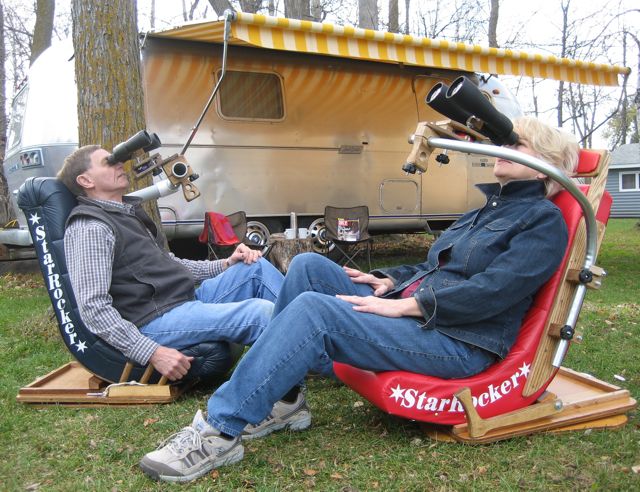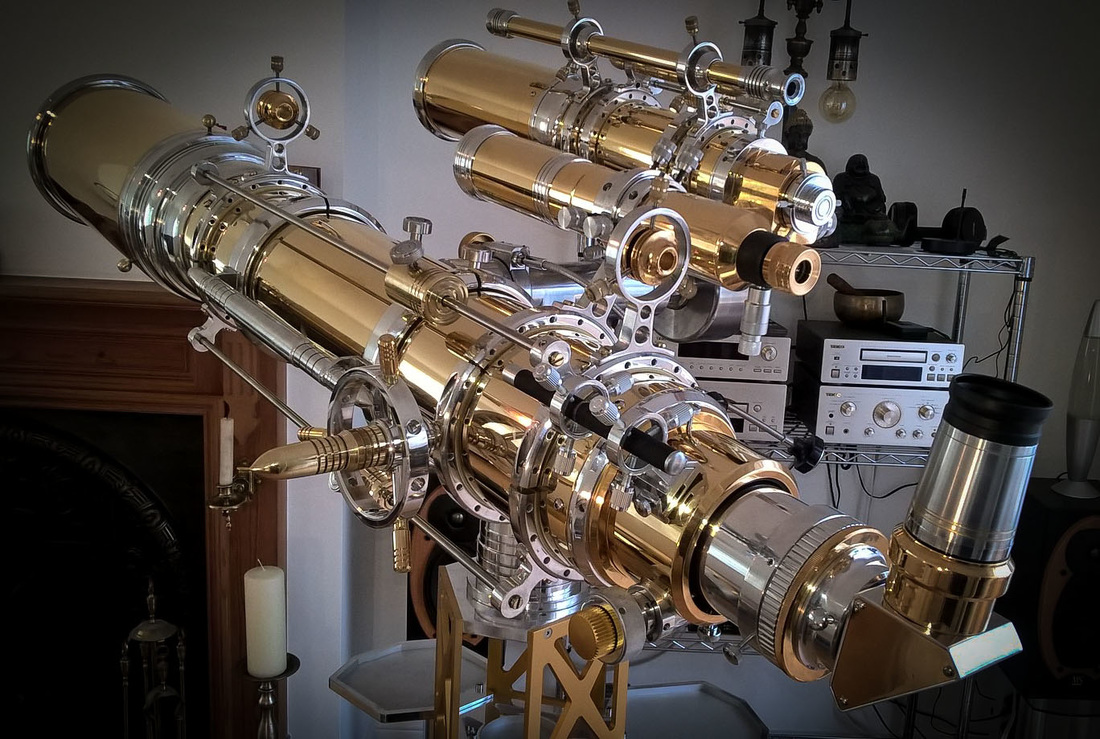
Louis D
-
Posts
9,363 -
Joined
-
Last visited
-
Days Won
1
Content Type
Profiles
Forums
Gallery
Events
Blogs
Posts posted by Louis D
-
-
First, don't bother with a 2x Barlow given the f/12 focal ratio and 1500mm focal length. The 8mm will provide just about the highest usable power with your scope.
The 25mm BST or a 32mm Plossl would work well for widest field. The BST would be wider and would fit in well with the rest of the BSTs.
If want to go wider, you can put a SCT thread adapter on the rear thread, install a 2" visual back on it, and then use a 2" diagonal. With a 2" diagonal, you can use wider 2" eyepieces. There is some vignetting and some odd reflections of bright stars with them, but I've found it actually works very well. Here's an image comparing the difference:
-
 1
1
-
-
2 hours ago, Don Pensack said:
at a high altitude site (2550m)
The Chula Vista Trailhead parking lot at Mt. Pinos, perchance? If I'm ever in CA with a telescope, I'll have to give it a try based on your ceaseless praise of that site.
-
24 minutes ago, Pixies said:
John. Would you say that it's quicker to set up the 200p as a dob, or on the AltAz? I would have thought that setting up the dob base would be much easier?
I have carrying handles on the sides of my Dob base, so I just carry the whole thing out in one go by hugging it close to my body. On an alt-az mount, it would be far too top heavy and awkward with the legs sticking out to safely get out the backdoor in one go. The tripod legs are always getting caught on the door frame. I can just manage it in one go with my 90mm APO and 127 Mak mounted on my DSV-2B, but I would not want to try it with an 8" Newt.
-
On 14/01/2021 at 12:22, Dixie said:
For the record 30 mm plossl eyepiece will give you the widest field of view with the 127 Mak. I use an Ultima 30 mm which is very nice. Orthos also work well, albeit with a smaller field of view.
Unless you've got the 2" visual back and diagonal of the US version. In that case, you can use widest field 2" eyepieces to good effect. There is some vignetting, but it isn't very noticeable to the human eye. Below is a comparison image I took through my 127 Mak to show the difference and resulting vignetting. The APM UFF 24m would be equivalent in TFOV to the 30mm/32mm Plossl.
-
3 hours ago, SiriusB said:
Any chance you could expand on this please for the benefit of all?
I'd been given to believe the best(bandwidth) nebula filters work best with larger scopes due to light loss? If you've only a small scope......
Thanks.
The contrast ratio remains the same regardless of aperture. If a filter passes 94% of the OIII lines with a 15nm Full Width, Half Maximum (FWHM) bandwidth, it will pass that amount of the emission lines and reject the light outside that width around the emission lines. As long as the passband is well centered on the emission lines, it's going to be effective at increasing contrast without reducing the OIII lines from the nebula. Having a wider passband will make the image brighter by passing more undesirable light around the OIII lines, but this is not desirable at any aperture since the whole goal is to increase contrast by rejecting as much undesirable light as possible.
I find OIII filters applicable to any aperture. Image brightness is determined by the exit pupil, not the aperture. Greater aperture does allow for a higher magnification at a given exit pupil and greater resolution. Basically, if the nebula dims too much with the OIII to be enjoyable, back off on the magnification to increase the exit pupil to brighten up the nebula. It will appear smaller, though.
-
 4
4
-
-
Welcome! I hope you've been able to get out under the stars with your new scope.
-
50 minutes ago, Fedele said:
one thing is certain though ... you Japanese make superb optics, but background music that is a distraction.
I Love Japan. 🙂So does my oldest daughter. She's been to Japan for vacation twice in the last few years. It's her favorite destination for travel.
-
 1
1
-
-
-
Yes, but did you try loosening the tiny grub screw with a fine screwdriver to see if it releases the donut so you can access the top of the reticle? It's right above the big illuminator hole. I don't want to try it with mine since it's working fine.
-
I looked at my copy of that eyepiece (the 20mm 70 degree, correct?). There's a small grub/set screw above the illuminator hole. I wonder if you could loosen it to drop the entire illuminator donut off of the upper barrel so you could access the top side of the reticle for cleaning.
-
If it is the same optically as the 9mm Meade HD-60 as many folks claim, then it is a very nice eyepiece. I've found it to be very well corrected across the field with excellent eye relief. I haven't done a critical analysis of stray light control or contrast, but it views similarly to my 9mm Vixen LV and 9mm Morpheus. It would certainly be a step up in comfort and field of view relative to the Plossl.
Here's a comparison image of the views through my ~9mm eyepieces in a field flattened AT72ED f/6 refractor. There's a Plossl and Kellner in the mix for comparison sake.
-
 1
1
-
-
1 minute ago, Zhombl said:
Thank you, John
Your understanding of specs is correct, and that's exactly what I needed to hear. I'll put my money aside for a moment. If I may ask, is there anything else you could advice regarding observations with this scope in the conditions I mentioned? Any advice appreciated.
Download and learn to use Stellarium to familiarize yourself with the sky and what's up in the sky on any given night at any given time in any given direction.
Also, become familiar with the Caldwell catalog and Messier objects. These two lists tend to cover the majority of the non-solar system showpiece objects in the sky that are good for beginners to hunt down and observe. Beware though, most galaxies and many emission nebula are difficult under light polluted skies, especially in an 80mm scope.
-
 1
1
-
-
I've got some "throw away" Kellners that came with scopes, and they're actually not that bad. Sure, the view is narrow and the eye relief is super tight, but they're decently sharp across the central 25 degrees or so. I'd give them a chance before tossing them on the scrapheap.
If I were to buy Plossls, I just get the GSO/Revelation/Astro Essentials because in an achromat, you're unlikely to see any difference between them and the NPLs.
-
 1
1
-
-
1 minute ago, michael.h.f.wilkinson said:
I am actually thinking of buying a house in southern France after I retire. Better weather than the Netherlands, and better food too. I speak the language well enough as well
I'm thinking of buying a house in the mountains of southeastern New Mexico after I retire. Less humid and cooler summers than Texas, pitch black skies (Bortle 2/3), and mostly clear nights. The food? Well, I'll take Texas barbecue and Tex-Mex over their Southwestern cuisine any day. I speak New Mexican well enough, I guess.
-
1 hour ago, Bongo said:
Wow! That seems counter-intuitive initially. but I'll give it a go as soon as these pesky clouds clear.
Why not? The worst outcome is loss of dark adaptation for a time. You may need to adjust the brightness down a bit to find the level that works best for your eyes.
-
 1
1
-
-
1 hour ago, SteveNickolls said:
We have little else to do here while waiting for the cloud/rain/snow/fog to clear away.
Sounds like New York weather. I lived upstate for 6 years, and the weather was awful to say the least. Even clear days were beset with smog that made clear skies look gray. I didn't get into astronomy until I moved to Deep in the heart of Texas.
The stars at night
Are big and bright
Deep in the heart of Texas
The prairie sky
Is wide and high
Deep in the heart of Texas-
 1
1
-
-
Thanks, I was wondering if the rotator's top thread was T2 because I couldn't find anything about it on Lacerta's site.
Also, I totally missed your newer thread. Thanks for the pointer.
-
Try shining a bright flashlight (torch) onto a piece of white paper and stare at it to force your rods into the active state then quickly look in the eyepiece at the Orion nebula. I've managed to catch a brief glimpse of green coloration using this technique with an 8" Dob.
-
 5
5
-
 1
1
-
-
@johninderby I'm resurrecting this thread because I'm thinking about getting the 2" version. You mention that you direct attached the 2" to 1.25" adapter to the rotation adapter via the thread. Which adapter are you using? Thanks!
-
-
 1
1
-
-
23 hours ago, AlexK said:
n addition, as far as I have mentioned a smartphone, I must mention the Celestron Starsense Explorer (CSSE) modern marvel. But so far it means you have to buy their telescope first . Then move its phone cradle to your telescope.
SkEye app works pretty good as well for push-to usage. You'll just need to rig up a phone holder starting with a car phone clamp to attach it to your scope.
-
Well, if you've got a counterweight rod like the following image:

You could get a green laser sight and use the rifle barrel clamp to attach it to the rod. You may need to wrap something incompressible around the rod to build it up the correct diameter for the clamp (1 inch). That's how I attached one to the handle of my DSV-1 alt-az mount.
-
 1
1
-
-
4 minutes ago, Zermelo said:
I understand now why some amateur observers like their kit to look cool as well as perform well - it's because they spend so long admiring it in their lounges.
I guess it's no surprise then that Moonraker Telescopes is based out of the UK.

-
 6
6
-
-
I truly pity you UK based astronomers. Perhaps you could consider moving to the Australian Outback for more consistently clear skies? 🤔
We've had plenty of pretty decently clear nights here in Texas. I've just been a bit too wiped out by the whole holidays thing to do much observing recently.













Whoo-Hoo! An image at long last - IC405
in Imaging - Deep Sky
Posted
Forgive me, but I couldn't resist. I downloaded your image and ran it through my 20 year old copy of Photoshop Elements 2.0. I did color/levels auto corrections followed by a manual levels adjust and increased saturation. It loses a bit in the faint areas, but gains a nice punch in the brighter areas. I'd say you've got a "bright" future ahead of you in astro imaging. 😎